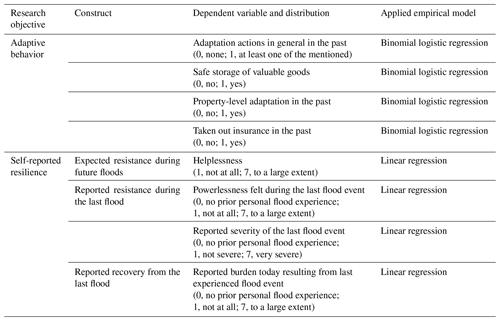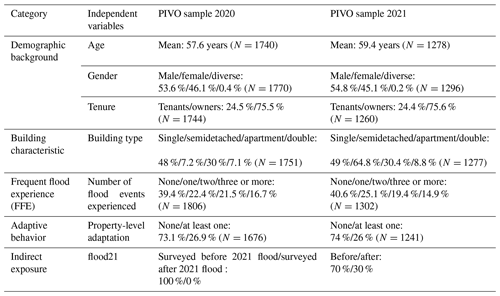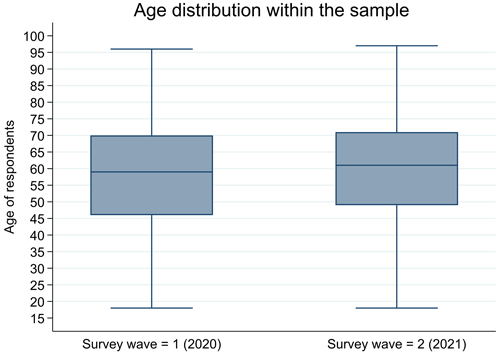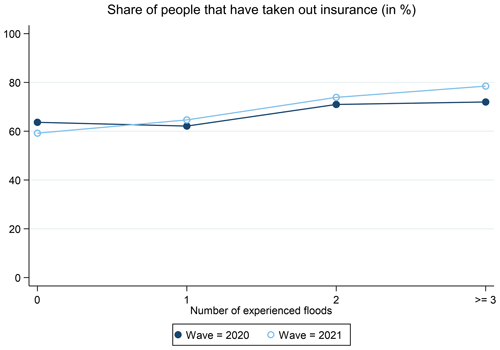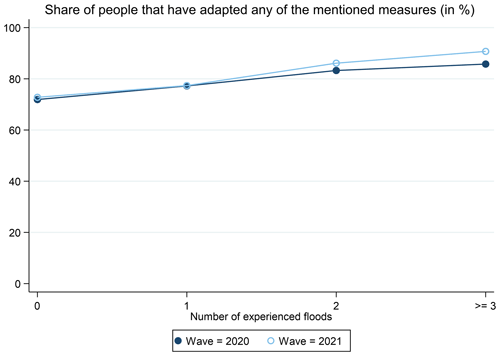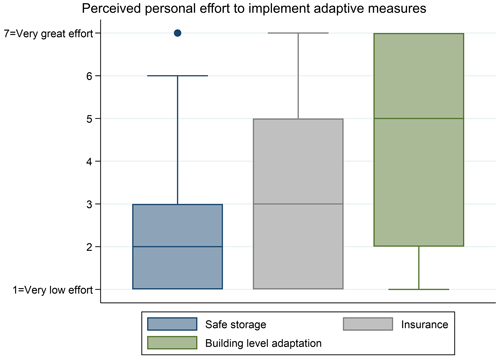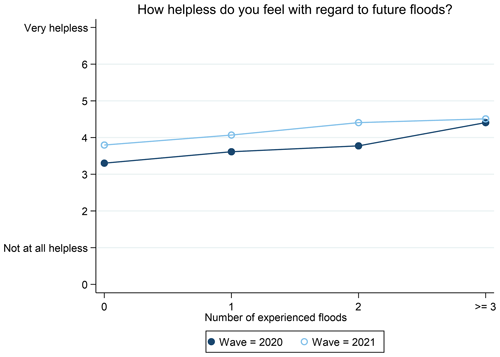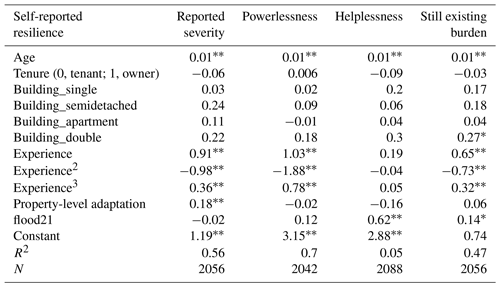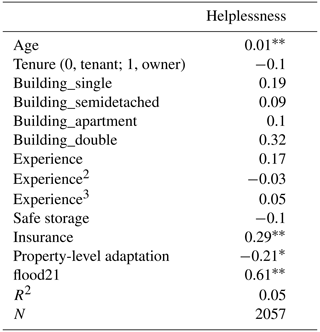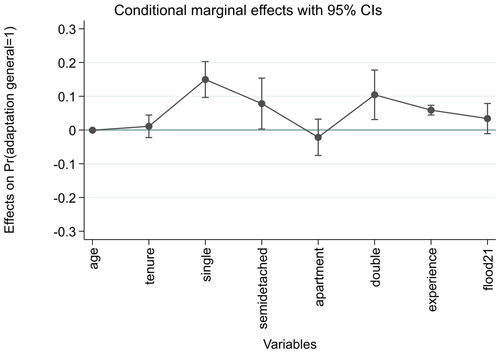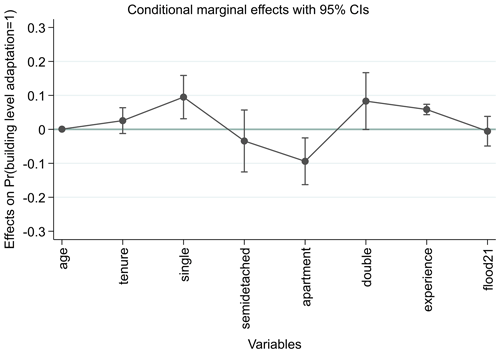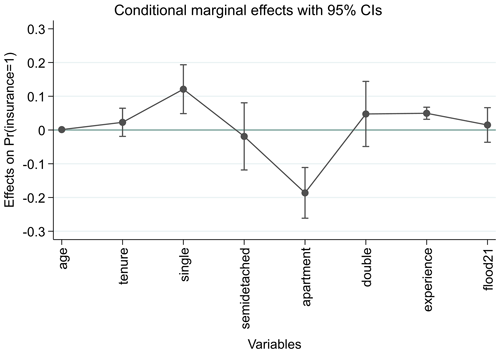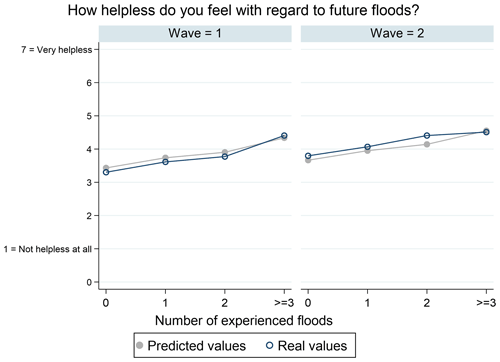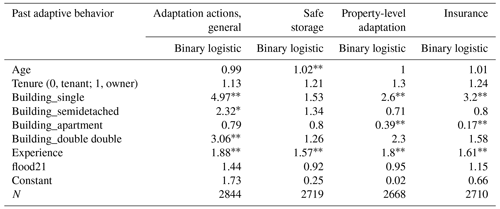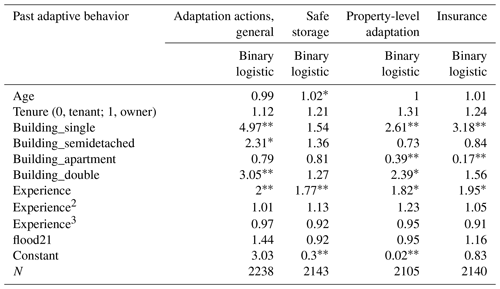the Creative Commons Attribution 4.0 License.
the Creative Commons Attribution 4.0 License.
Better prepared but less resilient: the paradoxical impact of frequent flood experience on adaptive behavior and resilience
Torsten Masson
Sabrina Köhler
Christian Kuhlicke
To better understand factors shaping adaptive behavior and resilience is crucial in designing policy strategies to prepare people for future flooding. The central question of our paper is how frequent flood experience (FFE) impacts adaptive behavior and self-reported resilience. The applied empirical methods are binary logistic and linear regression models using data from a panel dataset including 2462 residents (Germany, state of Saxony). Four main conclusions from the investigations can be drawn. First, more flood-experienced respondents are statistically significantly more likely to have taken precautionary measures in the past. Second, FFE has a statistically significant negative impact on self-reported resilience. Third, the impact of FFE on the capacity to recover and the capacity to resist is statistically significantly non-linear. Fourth, putting together these results reveals the paradox of more flood-experienced respondents being better prepared but feeling less resilient at the same time. It can be concluded that more research is needed to obtain deeper insights into the drivers behind self-reported resilience and that this study can be seen as a piece of the puzzle, taking frequent flood experience as the primary entry point.
- Article
(3721 KB) - Full-text XML
- BibTeX
- EndNote
The number and severity of floods are increasing globally (IPCC, 2023). The devastating flood in southwestern Germany in 2021 revealed unseen vulnerabilities, thereby shedding light on the current lack of knowledge regarding appropriate behavior and risk assessment (Fekete and Sandholz, 2021) and failures regarding early warning (Thieken et al., 2023). According to the Intergovernmental Panel on Climate Change (IPCC) Synthesis Report of 2023, global climate change is one reason for the increase in flood events (IPCC, 2023). This development challenges the status quo, putting individuals' mental and physical health, economic endowments, and important infrastructures at risk (GDV, 2021; Sieg et al., 2019; Thieken et al., 2016).
Despite this development in the face of climate change, the hazard can be made less of a disaster by reducing structural vulnerability, promoting adaptive behavior, and increasing resilience (Adger, 2006; Cutter, 1996; Aerts et al., 2018; Birkmann, 2011; Kreibich et al., 2017). For being able to promote adaptive behavior effectively, it is necessary to understand the underlying drivers better. While such drivers have long since entered the realm of science (e.g., Bubeck et al., 2018; Heidenreich et al., 2021; Kuhlicke et al., 2020a, b; Tasantab et al., 2022), it is less well understood how to improve resilience, being defined as the capacity to resist a hazardous event, recover from it, and adapt to it (IPCC, 2012). Additionally, previous research has focused on how flood experience generally affects the uptake of precautionary measures (Bamberg et al., 2017). In contrast, less work has been done investigating the effects of frequent flood experience (FFE). Additionally, only a few studies investigate experience's influence on resilience.
In our study, we aim to shed some light on the role of FFE, with respect to both adaptive behavior and self-reported resilience. It particularly contributes to the literature by focusing on the number of floods experienced. Our study suggests a paradoxical relationship between the development of resilience and the uptake of adaptive measures after experiencing multiple flood events. Whereas the likelihood to adopt such measures increases with the number of flood events experienced, self-reported resilience decreases. Additionally, we explore if the relationship between FFE and resilience is non-linear (Kuhlicke et al., 2020a). In other words, we test if individuals with very frequent flood experience report much lower resilience compared to individuals who have experienced fewer flood events.
The paper starts with an overview of related theories and existing knowledge to place this study and formulate its contribution (Sect. 2). This is followed by a description of the empirical modeling approach and the applied survey data of residents from flood-prone areas in the federal state of Saxony (Germany, Sect. 3). In Sect. 4, the results are presented, and they are discussed in Sect. 5.
2.1 Flood experience and resilience
The concept of resilience has different definitions depending on the field in which it is applied. In ecology, it is defined as the capacity of a system to keep its functioning and relations to other systems in the case of a disturbance (Holling, 1973). This definition aligns with that in sociology, where resilient systems are viewed as those that stay functional despite changing environmental conditions (Blum et al., 2016). In psychology, it is defined as the capacity of people to cope with and adapt to stress factors. It is a dynamic ability that alters with demographic conditions and life situations (Rutter, 1987; Norris et al., 2008). Connor and Davidson (2003) argue that individuals become more resilient through learning from challenging experiences and developing specific character traits that enable them to cope with a comparable situation better in the future. According to this argumentation and contrarily to that of Rutter (1987) and Norris et al. (2008), individuals stay resilient once they develop these character traits. Bonanno (2021) points out that it is difficult to predict which individuals will react resiliently to shocks, since the determinants of resilience vary in their impact depending on the specific situation. Moreover, Bonanno (2021) argues that resilience is connected with the ability of “flexible self-regulation”, enabling people to make decisions adjusted to the situation.
In natural hazard research, resilience is understood, among other things, as the capacity to resist a hazardous event's negative aftermath and adapt to and recover from it (IPCC, 2012; Cutter et al., 2008). Hudson et al. (2020) explain the capacity to resist as the ability to limit the impacts of a hazardous event, the capacity to adapt as the ability to be prepared for upcoming hazards of the same kind, and the capacity to recover as the time that the system needs to return to the pre-disaster state. In our study, we focus on the capacity to resist and to recover.
Existing studies aim at better understanding how flood experience affects people's resilience. It has been shown that floods have strong and long-term impacts on people's life both with respect to their physical health (Few et al., 2004; Jonkman and Kelman, 2005; Tapsell et al., 2009) and with respect to their psycho-social well-being (Bubeck and Thieken, 2018; Masson et al., 2019; Terpstra, 2011; Thieken et al., 2016). By comparing two independently collected survey datasets, Kuhlicke et al. (2020a) explore the interrelation between multiple flood experiences and resilience. They find that the resilience of households only increases with regard to respondents' perceived abilities to withstand impacts on equipment and mobile goods (e.g., cars, TV, and radios). A possible explanation they raise is the evolvement of routine-based knowledge. This positive influence of learning from floods is also pointed out by Kuang and Liao (2020), stating that it influences the capacities to resist, recover, and adapt. Concerning the self-perceived ability to reduce financial consequences, Kuhlicke et al. (2020a) observe non-linear trends, indicating that the relationship between flood experience and resilience changes when experiencing more floods. Lastly, the resilience of flood-prone households can decrease due to an under- or overestimation of the risk (Burton et al., 1978; Mol et al., 2020).
2.2 Flood experience and adaptive behavior
The IPCC (2012) defines adaptation as actions to adjust to changing conditions stemming from climate change aimed at reducing risks. A prominent approach to explaining adaptive/protective behavior is protection motivation theory (PMT) (Kuhlicke et al., 2023). Accordingly, if individuals' coping appraisal and risk perception are high, people are motivated to undertake actions (Grothmann and Reusswig, 2006; Heidenreich et al., 2021; Hudson et al., 2020; Maddux and Rogers, 1983). This is supported by Grothmann et al. (2013), who additionally summarize that the motivation to act is a primary psychological driver of actual adaptation. Besides the discussion of factors promoting adaptive actions, there is also a discussion of what psychological drivers hinder people from undertaking adaptive actions. These are, for example, ignorance, uncertainty, optimism bias, world views, and denial (Gifford, 2011).
Existing research explores whether and how flood experience shapes people's motivation to act. Studies indicate different relationships: while some suggest no relationship (Dessai and Sims, 2010; Whitmarsh, 2008), others observe a positive relationship (Grothmann and Reusswig, 2006; Hudson et al., 2017; Kuhlicke et al., 2020a; Osberghaus, 2017; Siegrist and Gutscher, 2008). One explanation for a positive relationship could be the factor of risk perception. In their meta-analysis, Bubeck et al. (2012) find that risk perception tends to be positively influenced by experience. Additionally, risk perception has been found to be a factor that increases individuals' willingness to undertake protective actions (Lazrus et al., 2016; Demski et al., 2017; Plapp, 2003; Siegrist and Gutscher, 2008). By applying a longitudinal study design including individuals before and after a flood event, Osberghaus (2017) shows a statistically positive impact of flood damage on private flood mitigation. Additionally, they find a correlation between self-reported flood experience and mitigation behavior. Tasantab et al. (2022) distinguish between flood experience and coping experience to explore how both influence people's intention to adapt. By extending protection motivation theory (PMT), their analysis indicates that flood experience, as well as coping experience, positively influences respondents' intentions to adapt. Both factors thus complement already established PMT factors such as fear, adaptation appraisal, and flood risk perception (Maddux and Rogers, 1983).
The adaptive actions of interest in our paper are storing important goods safely, having insurance against natural hazards, and undertaking property-level adaptation. Insurance against natural hazards is a private risk prevention through the distribution of financial damage over time that supports affected people after an event (Grothmann, 2005; Marg, 2016). Property-level adaptation prevents damage through avoidance, resistance, conceding, and securing before an event (DKKV, 2003 cited in Marg, 2016, 37–38).
The literature review reveals that the research fields of resilience and adaptive behavior in response to environmental hazards generally have captured many scholars' attention, and different perspectives have been developed. The specific investigation of the impact of experience with floods on adaptive behavior has also been studied well but with inconsistent results. However, the impact of experience on self-reported resilience has been studied to a lesser extent and also with varying outcomes regarding this relationship. The investigation of the impact of FFE in our study aims to deliver more robust results on these relationships by not only focusing on whether people have experienced floods or not but also considering the specific number of flood events experienced. Knowledge of the specific number of flood events experienced also allows for testing non-linear relationships, whereas in existing research, the focus is mainly on linear relationships. Lastly, in existing studies, the focus is mostly on the intention to adapt. However, our study focuses on actual behavior in the past as this is a more tangible and comparable outcome. Stemming from the existing literature and paradoxical research outcomes, our study contributes to the existing body of knowledge by aiming to answer the following research questions (RQs):
-
RQ 1: how does FFE motivate people to undertake adaptive actions?
-
RQ 2: how does FFE influence an individual's resilience in terms of their self-reported capacity to resist and recover?
-
RQ 3: how does past adaptive behavior impact reported resistance to future flood events?
The research area of our study is located in Germany, in the state of Saxony. The German federal state was impacted by five flood events between 2002 and 2013 (LfULG, 2015), with the events in 2002, 2010, and 2013 being the most severe (Sächsisches Staatsministerium für Energie, Klimaschutz, Umwelt und Landwirtschaft, 2018). According to a report by the Saxon State Office for Environment, Agriculture and Geology (LfULG, 2015), the flood event in 2013 caused damage in 378 of the 439 municipalities. In their report of 2018, the Saxonian Ministry for Environment and Agriculture highlights that 3.6 % of the federal state's surface belongs to the designated flood plains (BfUL, 2018). To meet our study's research goals, we follow a quantitative empirical modeling approach, applying regression analyses.
3.1 Survey sample
The data used stem from a two-wave paper-and-pencil survey collected in the PIVO project (Siedschlag et al., 2023). Data were collected in 11 communities in Saxony in 2020 and 2021, which were selected randomly out of a total of 25 communities (see Fig. 1).
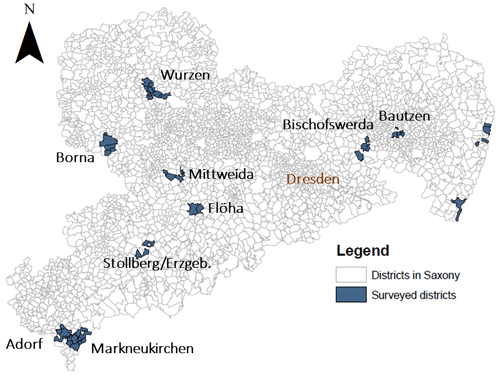
Figure 1Surveyed cities and districts (created with ArcGIS; basic map downloaded from Landesamt für Geobasisinformationen Sachsen, 2022).
The respondents from within the household were selected randomly by using a “next-birthday approach” (i.e., the questionnaire should be completed by the household member whose birthday is next and who is 18 years and older). The questionnaire was handed over personally and collected 1 week later, allowing individuals to complete the surveys privately. The sample of the first survey wave (2020) contains 1833 individuals; the sample from the second survey wave (2021) contains 1319 individuals, from which 690 (28.03 %) are part of both survey waves as presented in Table 1. For this paper, both survey waves are part of the investigation. This approach increases the overall sample size and allows us to benefit from the advantages of panel analyses, which decrease the problem of heterogeneity, consider intra-individual variations, and estimate the impact of changed external conditions (Brüderl, 2010).
3.2 Regression analysis and empirical model
3.2.1 Dependent variables and theoretical constructs
For the scope of our paper, multiple regression analyses with different dependent variables are performed. These are clustered in variables measuring adaptive behavior and self-reported resilience. Since the behavior and resilience variables are distributed differently, two different empirical modeling approaches are applied, binomial logistic and linear regressions. The reason for running separate regressions for the variables that are aimed at measuring the capacity to resist is that differences between reported resilience during past events and with regard to future events should be displayed.
The dependent variables and their distributions are presented in Table 2.
3.2.2 Independent variables
The independent variables refer to individuals' demographic backgrounds, their buildings' characteristics, and past flood experiences. For the investigation of the drivers of reported resilience, the fact of whether individuals have undertaken property-level adaptation in the past is included as an independent variable. Lastly, as some of the respondents included in the second survey wave were surveyed before and some after the devastating flood event of 2021 in western Germany, the binary distributed variable flood21 is included in the model to account for changes in the answers that externally stem from that event. For a detailed description of the independent variables, see Table 3 and Fig. 2.
3.2.3 Regression model
The resulting regression equations to measure adaptive behavior (Eq. 1) and self-reported resilience (Eq. 2) are
The model is run as a panel regression with random effects, since some individuals are included in both survey waves. The reason for applying random effects is that both the variance within an individual between the two survey waves and the differences between individuals are of interest. The analyses in Sect. 4 show non-linear relationships between FFE and reported resilience. Therefore, the squared and cubic forms of the mean-centered experience variable are included in Eq. (2).
4.1 Bivariate analyses of the relationship between flood experience, adaptive behavior, and self-reported resilience
The correlation analyses of the relationships between FFE and the outcome variables show that respondents who have experienced more flood events are also more likely to have implemented adaptive measures in the past. At the same time, individuals with more flood experience also report lower resilience. These outcomes lead to a paradoxical relationship. While FFE correlates positively with the uptake of adaptive measures, it negatively correlates with the self-reported resilience (Table 4).
Table 4Correlation coefficients: flood experience, adaptive behavior, and resilience.

* p < 0.05. p < 0.01.
Figures 3–6 show the percentage of people that have adopted the respective measure depending on the number of floods experienced for both survey waves. In Fig. 3, the values in both years are the same.

Figure 3Share of people that have stored their important goods more safely, depending on flood experience.
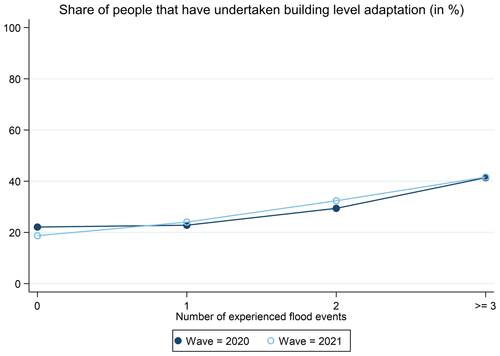
Figure 5Share of people that have undertaken property-level adaptation, depending on flood experience.
Stemming from Figs. 3–6, there are several key findings. First, independently of the number of floods experienced, respondents have more often applied measures of relatively low cost compared to measures with high costs, which was also found by Dillenardt et al. (2022) and Kuhlicke et al. (2020b). On a 1–7 Likert scale, the individuals in our dataset indicated that they associate the least effort with the action of storing important goods more safely (mean = 2.34; median = 2; SD = 1.54), followed by buying insurance against natural hazards (mean = 3.09; median = 3; SD = 2.03). They expect the highest effort to be associated with undertaking property-level adaptation (mean = 4.52; median = 5; SD = 2.3). Figure 7 shows these values for individuals who had not yet implemented the respective measure.
Second, respondents with high numbers of experienced floods (i.e., two and more) have more often taken measures than respondents with lower numbers (i.e., one or none). This applies to all constructs measured. Third, the least apparent relationship between FFE and behavior exists for insurance against natural hazards. This could be because many people already have insurance, independently of the exact number of flood events (about 67 % of the individuals in the dataset and 50 % of households in Saxony, which is above the German median; GDV, 2022).
Concerning self-reported resilience, several key findings can be reported (Figs. 8–11). First, the highest average value can be observed for the perceived powerlessness during the last flood event, independently of the number of flood events experienced. The lowest average value can be observed for the still existing burden, indicating that most respondents recovered quite well from the last flood event experienced. Second, respondents that had undergone three flood experiences reported considerably lower resilience across all variables measured than respondents with a one-time experience. Third, the impact of FFE on self-reported resilience varies. The relationship between experience and powerlessness felt during the last flood event and the extent to which the last flood is still perceived as a burden seems to follow a cubic relationship (reaching a plateau between the first and second flood and only increases again when a respondent experiences the third flood). A noticeable change in the slope, but without the previously described stagnation, can also be seen in the reported severity of the last flood event.
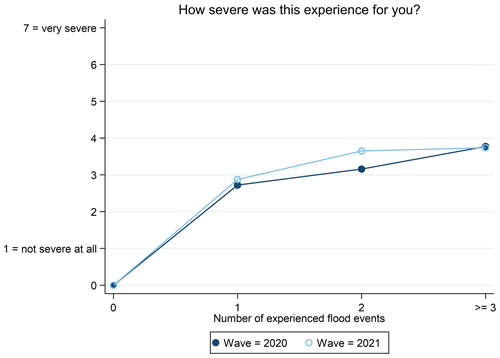
Figure 8Descriptive analysis of the relationship between perceived severity of the last flood and flood experience, both survey waves.
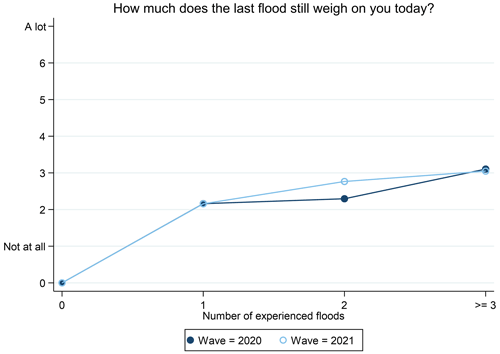
Figure 9Descriptive analysis of the relationship between still existing burden from the last flood and flood experience, both survey waves.
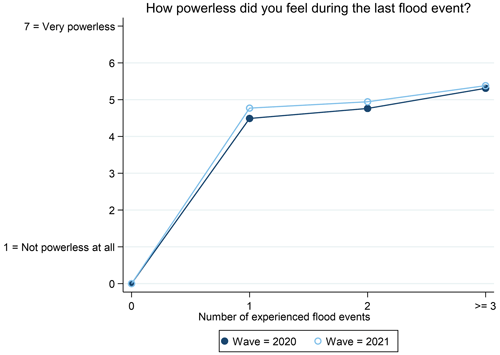
Figure 10Descriptive analysis of the relationship between powerlessness felt during the last flood and flood experience, both survey waves.
4.2 Empirical analyses
4.2.1 Adaptation behavior
The results of the regression analyses presented in Table 5 show that FFE plays a fundamental role in impacting adaptive behavior, not only in terms of effect strength but also in terms of statistical significance. According to the regression analyses, there is only a statistically significant linear relationship between FFE and adaptive behaviors. Therefore, only the linear form of the experience variable is included in the final model. The regression table, which includes the squared and cubic forms of the mean-centered experience variable, can be found in the Appendix (Table C2). The decision to eliminate the squared and cubic variables is also supported by the values for Akaike's information criterion (AIC) and the Bayesian information criterion (BIC), which are, in any case, lower for the models that only include the linear experience variable. The AIC and BIC measures can be found in the Appendix (Table D1) too.
Table 5Marginal effects of independent variables on adaptive behavior at the means.
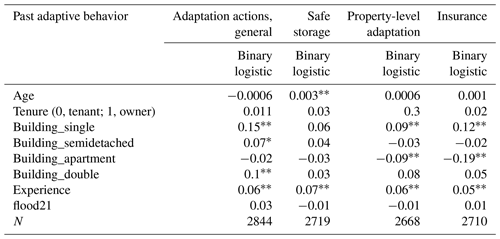
* p < 0.05. p < 0.01.
For a better understanding of the outcomes, the marginal effects instead of the odds ratios (ORs) are presented. The original regression tables, including the ORs, can be found in the Appendix (Table C1). The marginal effects do not vary fundamentally between the different actions. The FFE's most substantial effect is on whether individuals have stored their valuable goods more safely, with a marginal effect (ME) of 0.07. This indicates that a person with one more flood experience is 7 percentage points more likely to have stored their valuable goods more safely than a comparable person with one fewer experience. The most negligible impact is regarding the fact of whether people have taken out insurance (ME = 5 percentage points). However, the descriptive analyses in Fig. 4 suggest that this result has to be seen with caution, since the relation between the number of flood events experienced and the percentage of individuals taking out insurance does not follow a clear pattern.
4.2.2 Self-reported resilience
Compared to the influence on behavior, the impact of FFE on self-reported resilience is more diverse.
For the reported capacity to resist the aftermath of a flood event, the impact of the flood experience depends on the reference event in question: reported resilience during the past event or anticipated resilience during future events. A statistically significant non-linear relationship exists between FFE and the reported severity of the last flood event and the powerlessness felt during the last flood event. However, if the reference event is a future flood, there is no statistically significant impact, neither linear nor quadratic nor cubic. For the ability to recover from a past flood event, in terms of how much an individual still perceives the last flood event as a burden, the FFE has a statistically significant positive impact. This indicates that people need more time to recover when having experienced more flood events. As for the powerlessness felt and perceived severity of the last flood event, the outcomes of the regression analyses suggest a non-linear relationship between FFE and self-reported recovery.
To conclude, FFE has a statistically significant negative impact on resilience by lowering self-reported resistance during the last flood event and recovery from it. Additionally, the impact of FFE is only statistically significant when measuring its impact on self-reported resilience during past events. The same applies for non-linearity, as can be seen in the regression output table (Table 6).
A comparison of the fitted values from the estimation and the real average values can be found in the Appendix (Figs. B1–B4).
4.3 Including past adaptation behavior in the analysis of self-reported resilience
The analyses for the first and second research questions show that even though more experienced people are better prepared, their self-reported resilience decreases. Since this outcome is paradoxical, the interest of the third research question is in bringing anticipated helplessness during a future flood and past adaptive behavior into relation to each other. Therefore, the adaptation actions of safe storage, insurance, and property-level adaptation are included as independent variables in the model, taking anticipated helplessness during a future flood event as the outcome variable. The regression analysis shows that property-level adaptation in the past has a statistically significant negative influence on individuals' felt helplessness, whereas people who have previously taken out insurance feel statistically significantly more helpless. There is no statistically significant influence on storing important goods more safely. The regression output table is presented in Fig. 7.
5.1 Discussion of results
The outcomes of our analysis show that FFE has a positive impact on adaptive behavior and a negative impact on self-reported resilience, as well as that the influence of past behavior on future resilience depends on the measure.
5.1.1 RQ 1: how does FFE motivate people to undertake adaptive actions?
Drawing conclusions from the existing literature and research output, the assumption was that FFE motivates adaptive behaviors (Siegrist and Gutscher, 2008; Kuhlicke et al., 2020a; Osberghaus, 2017; Hudson et al., 2017). The statistical analyses of our paper support that assumption and previous findings.
A particularly interesting part of our study is that conclusions can be drawn from the chronological sequence of adaptation measures undertaken. Even though the regression analysis indicates that the relationship between FFE and behavior is generally linear, the bivariate analyses indicate some differences in timing. The first flood event has the most substantial impact on storing valuable goods more safely. The second flood has the most substantial impact on whether people have taken out insurance, and the (at least) third flood event has the most substantial impact on property-level adaptation. There could be several reasons for this order. First, the late shift of property-level adaptation could be because people still had to develop knowledge of appropriate measures, as discussed in Marg (2016). Second, economic considerations might play a role as property-level adaptation comes with financial investments. It has also been shown that the respondents in our sample expect the greatest effort in adaptation at the property level. Consequently, its perceived usefulness may only increase with the number of experienced floods, when people are more likely to perceive flooding as a reoccurring risk. Accordingly, the cost–benefit ratio might change with an increasing number of experienced floods, which positively impacts adaptive behavior at the property level. To put it another way, after the first flood event, that evaluation could result in favoring a rather low-effort action, such as storing valuable goods more safely. To sum up, the selection process of the appropriate adaptive behavior by comparing the protection level needed, necessary efforts, and available capacities might depend on the number of floods experienced. Lastly, as outlined in existing theories, the impact of flood experience on adaptive behavior could also be due to an increased perception of risk of the more experienced people (Grothmann and Reusswig, 2006; Heidenreich et al., 2021; Hudson et al., 2020; Maddux and Rogers, 1983). However, this has not been tested in our study and might be an objective for future work.
5.1.2 RQ 2: how does FFE influence an individual's resilience in terms of self-reported capacity to resist and recover?
The investigation of existing literature and research outputs has shown that the influence of FFE on resilience does not follow a clear pattern. Whereas some studies conclude that an individual's resilience to flood events increases when experiencing more flood events through, for example, learning effects (Connor and Davidson, 2003; Kuhlicke et al., 2020a; Kuang and Liao, 2020) and adaptive actions (Bubeck et al., 2012; Thieken et al., 2007), others come to the result that resilience decreases due to psychological consequences (Bubeck and Thieken, 2018; Masson et al., 2019; Terpstra, 2011) or an under- or overestimation of the risk (Burton et al., 1978; Mol et al., 2020). The empirical investigation of this paper shows that resilience, in terms of self-reported resistance during past events as well as future events and reported recovery after the last event, decreases when people experience multiple flood events. Comparing the reported expectation regarding individuals' resistance to future events with the reported resistance during the past event experienced indicates two major differences. First, the reported resilience during the last flood event most substantially decreases after the first flood experience. Contrarily, the most substantial decrease with regard to future floods happens after the third event. Second, people tend to have higher values for the powerlessness felt during the last flood event than for the anticipated helplessness during future events. One explanation for this outcome could be that adaptive behavior has a mediating impact. Our analyses show that adaptation behavior is positively influenced by flood experience. Accordingly, people that have experienced more floods have more likely undertaken actions and might therefore feel more protected and less helpless with regard to future floods, as undertaking such action can substantially reduce flood-related damage (Bubeck et al., 2012a; Kreibich et al., 2015; Thieken et al., 2007). However, our investigations for the third research question show that this explanation would only hold for the action of property-level adaptation because taking out insurance and storing important goods more safely do not have a statistically significant negative impact on reported helplessness. Lastly, under the assumption that both helplessness and powerlessness conceptualize the loss of control (Drew, 1990), the results could imply that people are better at memorizing past loss of control than assessing future loss of control. Aligning with that, individuals could perceive the past loss of control as more severe than they imagine the future loss.
The other pillar of resilience, the capacity to recover, follows a similar pattern to the capacity to resist future events. Accordingly, the most substantial development in the reported recovery occurs when individuals experience (at least) three flood events, with people having the most experience indicating the longest-lasting recovery. A possible explanation could be that people who have experienced more flood events are still busy with coping work related to earlier flood events. Additionally, the strain put on them from earlier floods might be difficult to separate from the strain that stems only from the last flood event.
The result that individuals' resilience decreases with the number of flood events experienced contradicts the development of resilience through experiences, as argued by Connor and Davidson (2003) and partly found in Kuhlicke et al. (2020a).
Linking the results of the first and second research questions reveals that, even though individuals indicate that they perceived their first flood event as severe and felt powerless, only the share of people that have adopted the lowest-threshold behavior of storing essential goods more safely changes substantially. One reason could be the psychological factor of optimism bias (Gifford, 2011). Applied to flood events, this could mean that people assume that the likelihood of experiencing a flood event decreases after being affected once. Uncertainty could also play a role (Gifford, 2011). Accordingly, experiencing one flood event might not deliver sufficient predictions of future events and their frequency for people to act. That could explain the shift in taking out insurance after the second flood event. After a reoccurring flood, more people may perceive it as a persisting risk and undertake actions, as described in Grothmann et al. (2013).
5.1.3 RQ 3: how does past adaptive behavior impact self-reported resistance to future flood events?
The assumption was that adaptive behaviors increase the self-reported capacity to resist future events, since people might feel better protected. Additionally, before deciding on an action, the anticipated information-seeking process could result in better knowledge of flood risks and possible actions during an event, leading to a higher perceived capacity to resist future events. However, this is not proved by the results of our study.
The empirical analyses show that undertaking property-level adaptation and storing essential goods more safely have a statistically negative impact on feeling helpless. However, only the influence of property-level adaptation is statistically significant. Individuals who have taken out insurance feel statistically significantly more helpless. There are several possible explanations for that outcome. First, it might be the case that people living in a high-risk area are more likely to take out insurance and generally feel more helpless. To consciously take that as an explanation, the analysis would have to include a measure for objective risk. Second, the reason could be the chronological order of flood hazards and the effect of insurance. Accordingly, insurance is a post-hazard coverage that financially compensates people when a hazard has happened (a household receives financial assistance from their insurance after their home is damaged by a flood). It could be the case that assumptions about feelings during the flood rather than flood-inherent obstacles after the event trigger the feeling of helplessness. Third, the reason could lie in the nature of insurance, covering damage financially. The feeling of helplessness might be influenced by the fear of losing personal belongings or the fear of damaged public infrastructure rather than the damage of goods that private insurance can compensate for (Grothmann, 2005). Fourth, the reason could be a matter of immaterial investments. Accordingly, even though people will be financially compensated, the organization of reconstruction remains mainly their responsibility (DKKV, 2003; Marg, 2016). This could be related to high time investment and physical and psychological efforts.
To conclude, our study shows that, with FFE in terms of the number of flood events experienced, individuals have lower self-reported capacities to resist during a flood event and a slower self-reported recovery. These developments are accompanied by increasing adaptive behavior. Consequently, people are better adapted to flood events in physical terms, but their psychological preparedness does not follow.
5.2 Limitations
One limitation of this study is that people were not asked for their exact number of flood events experienced after they had experienced three. Therefore, the impact of experiencing three flood events might be overestimated, since people with more flood experience are also in this group. The same applies for the difference between individuals with two and three flood events experienced. However, a problem with asking people for their exact number of flood events experienced could be that people do not correctly remember the number of floods, leading to biased results. Additionally, when asking for the correct number, the sample sizes of the groups of people with higher numbers of experienced floods might be too small and different from each other to obtain comparable results. A second limitation is that the dataset has no information on the objective risk of the last flood people experienced. Therefore, it is not known how severely they were impacted, which would be valuable information to objectively compare people's self-reported resilience. External data would have to be collected to obtain more information, for example, by applying flood hazard maps to the surveyed streets. Lastly, it is unknown if people took adaptive actions before or after the last flood event.
5.3 Implications and future research
As discussed in the Limitations subsection, there is no variable in the model that measures the impact of objective risk on the outcome variables. Therefore, in a future investigation, it might be interesting to include a measure for the objective severity to examine if that might have a different impact compared to the number of experienced floods. Adding to this, the investigation of the impact of flood experience on resilience shows that other factors must positively impact resilience independently of experience. These could be factors related to personality, neighborhood effects, and the physical severity of floods. A future investigation could include these factors. Bringing these outcomes into relation with existing research would support the scientific goal to better understand the development of resilience and how other factors impact it.
The paper's central question has been how the number of floods experienced impacts adaptive behavior and self-reported resilience. The result is that flood experience has a statistically significant positive impact on adaptive behavior and generally a statistically significant negative impact on self-reported resilience. The decrease in resilience does not happen linearly but stagnates after experiencing the second flood event and increases again after the third. To conclude, the group that has adapted the most is, at the same time, the group with the lowest self-reported resilience. An assumption is that experience also influences risk perception, decreasing self-reported resilience. However, this does not explain why the most adapted people need the most recovery time. Here, more research is needed. To sum up, the field of natural hazard research is very well represented in science. Particularly the field of adaptive behavior has been investigated to a large extent. However, the field of resilience, particularly the drivers of it, still demands much interdisciplinary research to obtain better insights. Here, the paper contributes to existing knowledge by investigating the impact of the number of flood events experienced on self-reported resilience. Due to the sample composition of having different groups depending on the number of flood events experienced, conclusions can be drawn on the timely sequence of the change in self-reported resilience.
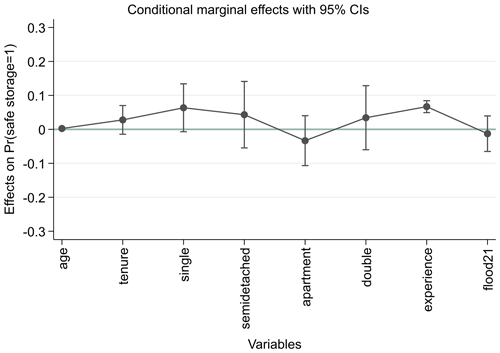
Figure A2Conditional marginal effects on the probability of having stored valuable goods more safely.
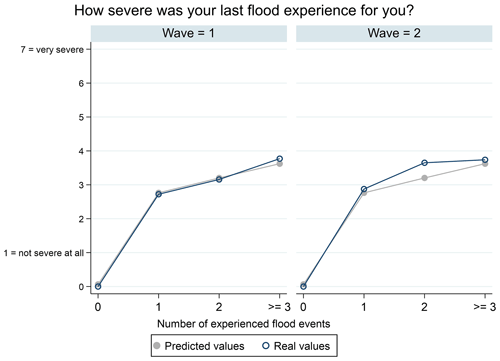
Figure B1Comparison of mean outcomes of the fitted model and real data: severity of last flood event.
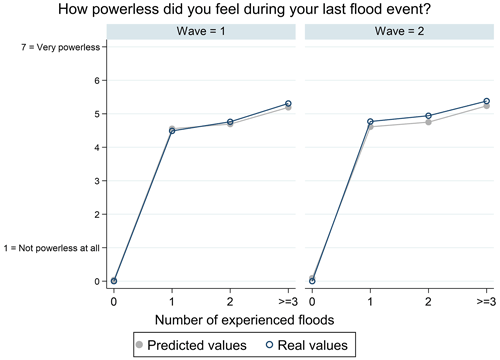
Figure B2Comparison of mean outcomes of the fitted model and real data: powerlessness felt during the last flood.
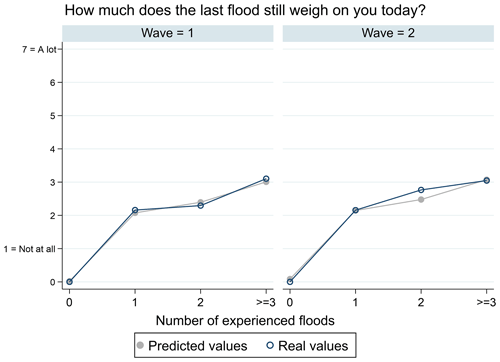
Figure B3Comparison of mean outcomes of the fitted model and real data: still existing burden from the last flood.
Data used for this study and codes for the analyses can be made available for scientific use upon request to the corresponding author.
LK, SK, TM, and CK conceptualized this study. SK, TM, and CK collected data. LK and TM developed the model. LK performed the formal analysis and prepared the results. The original draft was written by LK and reviewed and edited by the co-authors. LK prepared the final manuscript for submission.
The contact author has declared that none of the authors has any competing interests.
Publisher’s note: Copernicus Publications remains neutral with regard to jurisdictional claims in published maps and institutional affiliations.
This research has been supported by the Deutsche Forschungsgemeinschaft (grant no. GRK 2043, project number 25103684) as well as by the Federal Ministry for the Environment, Nature Conservation, Nuclear Safety and Consumer Protection German Environmental Office through the PIVO project (UBA, grant no. 3718 48 101 0).
This paper was edited by Sven Fuchs and reviewed by two anonymous referees.
Aerts, J. C. J. H., Botzen, W. J., Clarke, K. C., Cutter, S. L., Hall, J. W., Merz, B., Michel-Kerjan, E., Mysiak, J., Surminski, S., and Kunreuther, H.: Integrating human behaviour dynamics into flood disaster risk assessment perspective, Nat. Clim. Change, 8, 193–199, https://doi.org/10.1038/s41558-018-0085-1, 2018.
Adger, W. N.: Vulnerability, Global Environ. Chang., 16, 268–281, https://doi.org/10.1016/j.gloenvcha.2006.02.006, 2006.
Bamberg, S., Masson, T., Brewitt, K., and Nemetschek, N.: Threat, coping and flood prevention – A meta-analysis, J. Environ. Psychol., 54, 116–126, https://doi.org/10.1016/j.jenvp.2017.08.001, 2017.
Birkmann, J.: First- and second-order adaptation to natural hazards and extreme events in the context of climate change, Nat. Hazards, 58, 811–840, https://doi.org/10.1007/s11069-011-9806-8, 2011.
Blum, M., Ducoing, C., and McLaughlin, E.: Genuine Savings in developing and developed countries, 1900–2000, Environ. Econ. Discuss. Pap., 2016–15, 1–34, https://ideas.repec.org/p/sss/wpaper/2016-15.html (last access: 10 August 2023), 2016.
Bonanno, G. A.: The resilience paradox, Eur. J. Psychotraumato., 12, 1–8, https://doi.org/10.1080/20008198.2021.1942642, 2021.
Brüderl, J.: Kausalanalyse mit Paneldaten, in: Handbuch der sozialwissenschaftlichen Datenanalyse, 963–994, https://doi.org/10.1007/978-3-531-92038-2, 2010.
Bubeck, P. and Thieken, A. H.: What helps people recover from floods? Insights from a survey among flood-affected residents in Germany, Reg. Environ. Change, 18, 287–296, https://doi.org/10.1007/s10113-017-1200-y, 2018.
Bubeck, P., Botzen, W. J. W., and Aerts, J. C. J. H.: A Review of Risk Perceptions and Other Factors that Influence Flood Mitigation Behavior, Risk Anal., 32, 1481–1495, https://doi.org/10.1111/j.1539-6924.2011.01783.x, 2012a.
Bubeck, P., Botzen, W. J. W., Kreibich, H., and Aerts, J. C. J. H.: Long-term development and effectiveness of private flood mitigation measures: an analysis for the German part of the river Rhine, Nat. Hazards Earth Syst. Sci., 12, 3507–3518, https://doi.org/10.5194/nhess-12-3507-2012, 2012b.
Bubeck, P., Botzen, W. J. W., Laudan, J., Aerts, J. C. J. H., and Thieken, A. H.: Insights into Flood-Coping Appraisals of Protection Motivation Theory: Empirical Evidence from Germany and France, 38, 1239–1257, https://doi.org/10.1111/risa.12938, 2018.
Burton, I., Kates, R. W., and White, G. F.: The environment as hazard, New York Oxford Univ. Press, ISBN 0-19-502221, 1978.
Connor, K. M. and Davidson, J. R. T.: Development of a new Resilience scale: The Connor-Davidson Resilience scale (CD-RISC), Depress. Anxiety, 18, 76–82, https://doi.org/10.1002/da.10113, 2003.
Cutter, S. L.: Vulnerability to hazards, Prog. Hum. Geog., 20, 529–539, https://doi.org/10.1177/03091325960200040, 1996.
Cutter, S. L., Barnes, L., Berry, M., Burton, C., Evans, E., Tate, E., and Webb, J.: A place-based model for understanding community resilience to natural disasters, Glob. Environ. Change, 18, 598–606, https://doi.org/10.1016/j.gloenvcha.2008.07.013, 2008.
Demski, C., Capstick, S., Pidgeon, N., Sposato, R. G., and Spence, A.: Experience of extreme weather affects climate change mitigation and adaptation responses, Clim. Change, 140, 149–164, https://doi.org/10.1007/s10584-016-1837-4, 2017.
Dessai, S. and Sims, C.: Public perception of drought and climate change in southeast england, Environ. Hazards-UK, 9, 340–357, https://doi.org/10.3763/ehaz.2010.0037, 2010.
Dillenardt, L., Hudson, P., and Thieken, A. H.: Urban pluvial flood adaptation: Results of a household survey across four German municipalities, J. Flood Risk. Manag., 15, 1–15, https://doi.org/10.1111/jfr3.12748, 2022.
Drew, B. L.: Differentiation of Hopelessness, Helplessness, and Powerlessness Using Erik Erikson's “Roots of Virtue”, Arch. Psychat. Nurs., 4, 332–337, 1990.
Fekete, A. and Sandholz, S.: Here comes the flood, but not failure? Lessons to learn after the heavy rain and pluvial floods in germany 2021, Water, 13, 1–20, https://doi.org/10.3390/w13213016, 2021.
Few, R., Ahern, M., Matthies, F., and Kovats, S.: Floods, health and climate change: a strategic review, Tyndall Cent. Clim. Chang. Res. Work. Pap., 63, 1–138, http://www.tyndall.ac.uk/publications/working_papers/wp63_summary.shtml%5Cnhttp://tyndall.ac.uk/sites/default/files/wp63.pdf (last access: 10 August 2023), 2004.
GDV: Versicherungsschäden durch Flutkatastrophe bei rund sieben Milliarden Euro, https://www.gdv.de/gdv/medien/medieninformationen/ (last access: 10 August 2023), 2021.
GDV: Umfassend gegen Naturgefahren versichert (Elementarschäden), https://www.gdv.de/resource/blob/32296/4ea9c03c9217fee19c (last access: 10 August 2023), 2022.
Gifford, R.: The Dragons of Inaction: Psychological Barriers That Limit Climate Change Mitigation and Adaptation, Am. Psychol., 66, 290–302, https://doi.org/10.1037/a0023566, 2011.
Grothmann, T.: Klimawandel, Wetterextreme und private Schadensprävention, Entwicklung Überprüfung und praktische Anwendbarkeit, PhD thesis, https://doi.org/10.25673/4665, 2005.
Grothmann, T. and Reusswig, F.: People at risk of flooding: Why some residents take precautionary action while others do not, Nat. Hazards, 38, 101–120, https://doi.org/10.1007/s11069-005-8604-6, 2006.
Grothmann, T., Grecksch, K., Winges, M., and Siebenhüner, B.: Assessing institutional capacities to adapt to climate change: integrating psychological dimensions in the Adaptive Capacity Wheel, Nat. Hazards Earth Syst. Sci., 13, 3369–3384, https://doi.org/10.5194/nhess-13-3369-2013, 2013.
Heidenreich, A., Köhler, S., Seebauer, S., Masson, T., Seebauer, S., and Köhler, S.: Schutzhandeln bei Hochwasser, Hitze und Co. – Umweltpsychologische Theorien für die Naturrisikenforschung, Umweltpsychologie, 2 , 92–109, https://www.uni-potsdam.de/fileadmin/projects/extrass/Heidenreich--Schutzhandeln_bei_Hochwasser_Hitze_und_Co--Umweltpsychologische_Theorien_fuer_die_Naturrisikenforschung--2020.pdf (last access: 10 August 2023), 2021.
Holling, C. S.: Resilience and stability of ecological systems, Annu. Rev. Ecol. Syst., 4, 1–23, 1973.
Hudson, P., Wouter Botzen, W. J., Czajkowski, J., and Kreibich, H.: Moral Hazard in Natural Disaster Insurance Markets: Empirical Evidence from Germany and the United States, Land Econ., 93, 179–208, https://doi.org/10.3368/le.93.2.179, 2017.
Hudson, P., De Ruig, L. T., de Ruiter, M. C., Kuik, O. J., Botzen, W. J. W., Le Den, X., Persson, M., Benoist, A., and Nielsen, C. N.: An assessment of best practices of extreme weather insurance and directions for a more resilient society, Environ. Hazards-UK, 19, 301–321, https://doi.org/10.1080/17477891.2019.1608148, 2020a.
Hudson, P., De Ruig, L. T., de Ruiter, M. C., Kuik, O. J., Botzen, W. J. W., Le Den, X., Persson, M., Benoist, A., and Nielsen, C. N.: An assessment of best practices of extreme weather insurance and directions for a more resilient society, Environ. Hazards-UK, 19, 301–321, https://doi.org/10.1080/17477891.2019.1608148, 2020b.
IPCC: Managing the Risks of Extreme Events and Disasters to Advance Climate Change Adaptation, 339–392 pp., https://doi.org/10.1017/CBO9781139177245.009, 2012.
IPCC: Synthesis Report. A Report of the Intergovernmental Panel on Climate Change. Contribution of Working Groups I, II and III to the Sixth Assessment Report of the Intergovernmental Panel on Climate Change, edited by: Core Writing Team, Lee, H., and Romero, J., European University Institute, IPCC, Geneva, Switzerland, https://report.ipcc.ch/ar6syr/pdf/IPCC_AR6_SYR_LongerReport.pdf (last access: 10 August 2023), 2023.
Jonkman, S. N. and Kelman, I.: An analysis of the causes and circumstances of flood disaster deaths, Disasters, 29, 75–97, https://doi.org/10.1111/j.0361-3666.2005.00275.x, 2005.
Kreibich, H., Bubeck, P., Van Vliet, M., and De Moel, H.: A review of damage-reducing measures to manage fluvial flood risks in a changing climate, Mitig. Adapt. Strateg. Gl., 20, 967–989, https://doi.org/10.1007/s11027-014-9629-5, 2015.
Kreibich, H., Di Baldassarre, G., Vorogushyn, S., Aerts, J. C. J. H., Apel, H., Aronica, G. T., Arnbjerg-Nielsen, K., Bouwer, L. M., Bubeck, P., Caloiero, T., Chinh, D. T., Cortès, M., Gain, A. K., Giampá, V., Kuhlicke, C., Kundzewicz, Z. W., Llasat, M. C., Mård, J., Matczak, P., Mazzoleni, M., Molinari, D., Dung, N. V., Petrucci, O., Schröter, K., Slager, K., Thieken, A. H., Ward, P. J., and Merz, B.: Adaptation to flood risk: Results of international paired flood event studies, Earths Future, 5, 953–965, https://doi.org/10.1002/2017EF000606, 2017.
Kuang, D. and Liao, K.: Learning from Floods: Linking flood experience and flood resilience, J. Environ. Manage., 271, 111025, https://doi.org/10.1016/j.jenvman.2020.111025, 2020.
Kuhlicke, C., Masson, T., Kienzler, S., Sieg, T., Thieken, A. H., and Kreibich, H.: Multiple flood experiences and social resilience: findings from three surveys on households and companies exposed to the 2013 flood in germany, Weather. Clim. Soc., 12, 63–88, https://doi.org/10.1175/WCAS-D-18-0069.1, 2020a.
Kuhlicke, C., Seebauer, S., Hudson, P., Begg, C., Bubeck, P., Dittmer, C., Grothmann, T., Heidenreich, A., Kreibich, H., Lorenz, D. F., Masson, T., Reiter, J., Thaler, T., Thieken, A. H., and Bamberg, S.: The behavioral turn in flood risk management, its assumptions and potential implications, WIRES Water, 7, 1–22, https://doi.org/10.1002/wat2.1418, 2020b.
Kuhlicke, C., Madruga de Brito, M., Bartkowski, B., Botzen, W., Doğulu, C., Han, S., Hudson, P., Nuray Karanci, A., Klassert, C. J., Otto, D., Scolobig, A., Moreno Soares, T., and Rufat, S.: Spinning in circles? A systematic review on the role of theory in social vulnerability, resilience and adaptation research, Glob. Environ. Change, 80, https://doi.org/10.1016/j.gloenvcha.2023.102672, 2023.
Lazrus, H., Morss, R. E., Demuth, J. L., Lazo, J. K., and Bostrom, A.: “Know What to Do If You Encounter a Flash Flood”: Mental Models Analysis for Improving Flash Flood Risk Communication and Public Decision Making, Risk Anal., 36, 411–427, https://doi.org/10.1111/risa.12480, 2016.
LfULG: Ereignisanalyse Hochwasser Juni 2013, 1–251, https://publikationen.sachsen.de/bdb/artikel/15180 (last access: 10 August 2023), 2015.
Maddux, J. E. and Rogers, R. W.: Protection motivation and self-efficacy: A revised theory of fear appeals and attitude change, J. Exp. Soc. Psychol., 19, 469–479, https://doi.org/10.1016/0022-1031(83)90023-9, 1983.
Marg, O.: Resilienz von Haushalten gegenüber extremen Ereignissen, Springer Fachmedien Wiesbaden, https://doi.org/10.1007/978-3-658-14256-8, 2016.
Masson, T., Bamberg, S., Stricker, M., and Heidenreich, A.: “We can help ourselves”: does community resilience buffer against the negative impact of flooding on mental health?, Nat. Hazards Earth Syst. Sci., 19, 2371–2384, https://doi.org/10.5194/nhess-19-2371-2019, 2019.
Mol, J. M., Botzen, W. J. W., Blasch, J. E., and de Moel, H.: Insights into Flood Risk Misperceptions of Homeowners in the Dutch River Delta, Risk Anal., 40, 1450–1468, https://doi.org/10.1111/risa.13479, 2020.
Norris, F. H., Stevens, S. P., Pfefferbaum, B., Wyche, K. F., and Pfefferbaum, R. L.: Community resilience as a metaphor, theory, set of capacities, and strategy for disaster readiness, Am. J. Commun. Psychol., 41, 127–150, https://doi.org/10.1007/s10464-007-9156-6, 2008.
Osberghaus, D.: The effect of flood experience on household mitigation – Evidence from longitudinal and insurance data, Glob. Environ. Change, 43, 126–136, https://doi.org/10.1016/j.gloenvcha.2017.02.003, 2017.
Plapp, T.: Wahrnehmung von Risiken aus Naturkatastrophen: Eine empirische Untersuchung in sechs gefährdeten Gebieten Süd- und Westdeutschlands, PhD Thesis, Universität Fridericiana zu Karlsruhe, 310 pp., https://publikationen.bibliothek.kit.edu/3542003 (last access: 10 August 2023), 2003.
Rutter, M.: Psychosocial resilience and protective mechanisms, Am. J. Orthopsychiat., 57, 316–331, https://doi.org/10.1080/15421406.2011.571932, 1987.
Sachsen: Offene Geodaten, Downloadbereich Ortsteile, https://www.geodaten.sachsen.de/downloadbereich-ortsteile-4346.html (last access: 10 August 2023), 2022.
Sächsisches Staatsministerium für Energie, Klimaschutz, Umwelt und Landwirtschaft: Hochwasser geht alle an!, 1–32, https://publikationen.sachsen.de/bdb/artikel/15391, last access: 10 August 2023, 2018.
Siedschlag, D., Kuhlicke, C., Köhler, S., Masson, T., Bamberg, S., Olfert, A., Hutter, G., Osberghaus, D., and Barth, M.: Risikokommunikation zur Stärkung privater Eigenvorsorge, Abschlussbericht des Vorhabens “Analyse und Anwendung innovativer Instrumente der Steuerung und Kommunikation zur Anpassung an den Klimawandel”, Umweltbundesamt, 1–225, https://www.umweltbundesamt.de/publikationen/risikokommunikation-zur-staerkung-privater (last access: 10 August 2023), 2023.
Sieg, T., Schinko, T., Vogel, K., Mechler, R., Merz, B., and Kreibich, H.: Integrated assessment of short-term direct and indirect economic flood impacts including uncertainty quantification, PLOS One, 14, 1–21, https://doi.org/10.1371/journal.pone.0212932, 2019.
Siegrist, M. and Gutscher, H.: Natural hazards and motivation for mitigation behavior: People cannot predict the affect evoked by a severe flood, Risk Anal., 28, 771–778, https://doi.org/10.1111/j.1539-6924.2008.01049.x, 2008.
Tapsell, S., Tunstall, S., and Priest, S.: Developing a conceptual model of flood impacts upon human health, FLOODSITE Project Report, T10-09-02, https://api.semanticscholar.org/CorpusID:127701215 (last access: 10 August 2023), 2009.
Tasantab, J. C., Gajendran, T., and Maund, K.: Expanding protection motivation theory: The role of coping experience in flood risk adaptation intentions in informal settlements, Int. J. Disast. Risk Re., 76, 103020, https://doi.org/10.1016/j.ijdrr.2022.103020, 2022.
Terpstra, T.: Emotions, Trust, and Perceived Risk: Affective and Cognitive Routes to Flood Preparedness Behavior, Risk Anal., 31, 1658–1675, https://doi.org/10.1111/j.1539-6924.2011.01616.x, 2011.
Thieken, A. H., Kreibich, H., Müller, M., Merz, B., Thieken, A. H., Kreibich, H., and Müller, M.: Coping with floods: preparedness, response and recovery of flood-affected residents in Germany in 2002, 52, 101–1037, https://doi.org/10.1623/hysj.52.5.1016, 2007.
Thieken, A. H., Bessel, T., Kienzler, S., Kreibich, H., Müller, M., Pisi, S., and Schröter, K.: The flood of June 2013 in Germany: how much do we know about its impacts?, Nat. Hazards Earth Syst. Sci., 16, 1519–1540, https://doi.org/10.5194/nhess-16-1519-2016, 2016.
Thieken, A. H., Bubeck, P., Heidenreich, A., von Keyserlingk, J., Dillenardt, L., and Otto, A.: Performance of the flood warning system in Germany in July 2021 – insights from affected residents, Nat. Hazards Earth Syst. Sci., 23, 973–990, https://doi.org/10.5194/nhess-23-973-2023, 2023.
Whitmarsh, L.: Are flood victims more concerned about climate change than other people? the role of direct experience in risk perception and behavioural response, J. Risk Res., 11, 351–374, https://doi.org/10.1080/13669870701552235, 2008.
- Abstract
- Introduction
- Theoretical background and existing knowledge
- Case study and methodology
- Results
- Discussion
- Summary and conclusions
- Appendix A: Marginal effects on adaptive behavior
- Appendix B: Comparison of mean outcomes of the fitted model and real data
- Appendix C: Regression output table: adaptive behavior
- Appendix D: AIC and BIC values, depending on the inclusion of experience variables
- Code and data availability
- Author contributions
- Competing interests
- Disclaimer
- Financial support
- Review statement
- References
- Abstract
- Introduction
- Theoretical background and existing knowledge
- Case study and methodology
- Results
- Discussion
- Summary and conclusions
- Appendix A: Marginal effects on adaptive behavior
- Appendix B: Comparison of mean outcomes of the fitted model and real data
- Appendix C: Regression output table: adaptive behavior
- Appendix D: AIC and BIC values, depending on the inclusion of experience variables
- Code and data availability
- Author contributions
- Competing interests
- Disclaimer
- Financial support
- Review statement
- References







